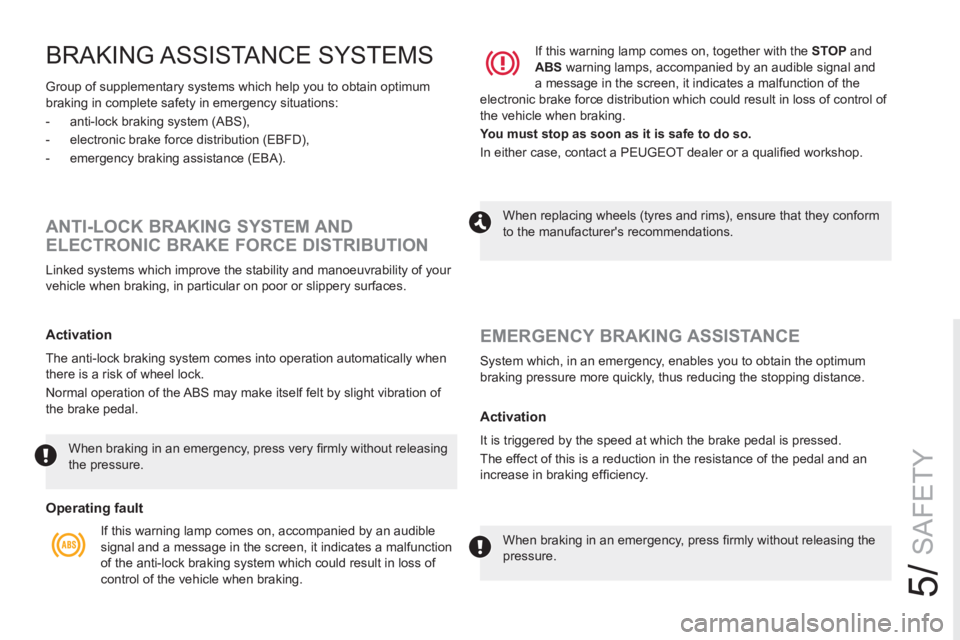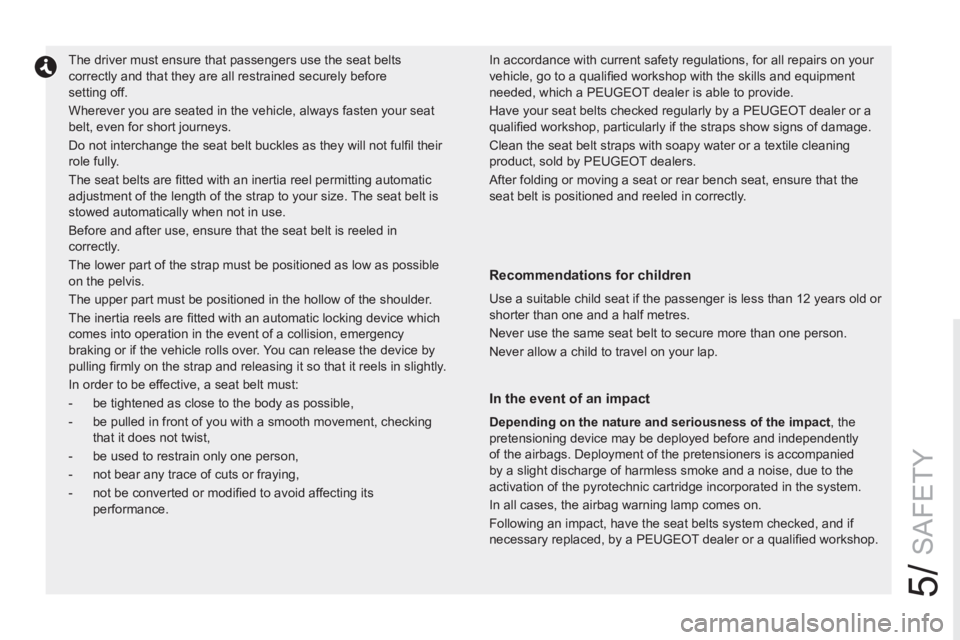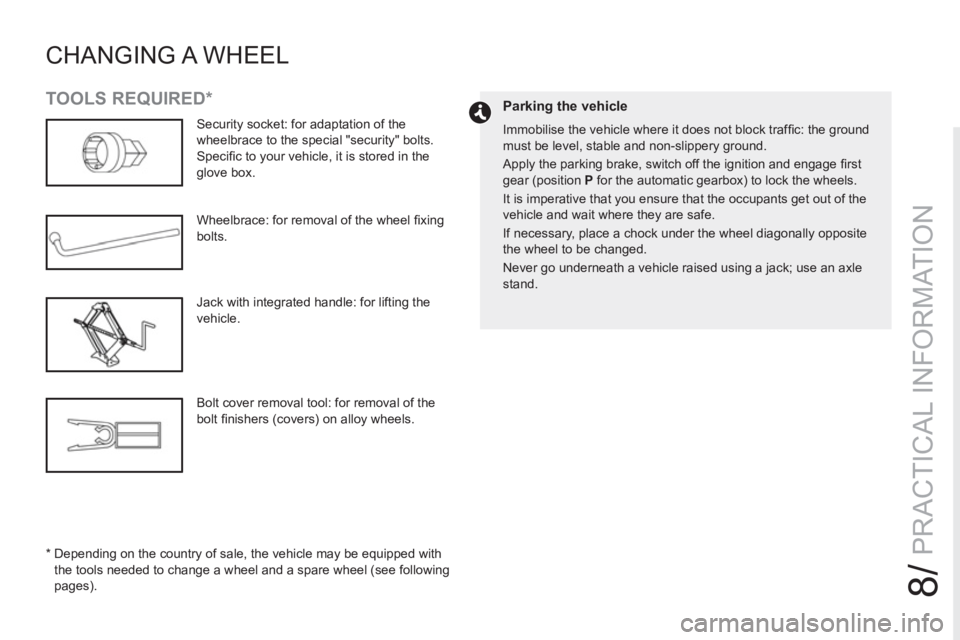2012 PEUGEOT RCZ lock
[x] Cancel search: lockPage 107 of 336

5/
SAFETY
BRAKING ASSISTA NCE SYSTEMS
Group of supplementary systems which help you to obtain optimum
braking in complete safety in emergency situations:
- anti-lock braking system (ABS),
- electronic brake force distribution (EBFD),
- emergency braking assistance (EBA).
ANTI-LOCK BRAKING SYSTEM AND
ELECTRONIC BRAKE FORCE DISTRIBUTION
Linked systems which improve the stability and manoeuvrability of your
vehicle when braking, in particular on poor or slippery surfaces.
Activation
The anti-lock braking system comes into operation automatically when
there is a risk of wheel lock.
Normal operation of the ABS may make itself felt by slight vibration of
the brake pedal.
When braking in an emergency, press very fi rmly without releasing
the pressure.
Operating fault
If this warning lamp comes on, accompanied by an audible
signal and a message in the screen, it indicates a malfunction
of the anti-lock braking system which could result in loss of
control of the vehicle when braking. If this warning lamp comes on, together with the STOP
and
ABS
warning lamps, accompanied by an audible signal and
a message in the screen, it indicates a malfunction of the
electronic brake force distribution which could result in loss of control of
the vehicle when braking.
You must stop as soon as it is safe to do so.
In either case, contact a PEUGEOT dealer or a qualifi ed workshop.
When replacing wheels (tyres and rims), ensure that they conform
to the manufacturer's recommendations.
When braking in an emergency, press fi rmly without releasing the
pressure.
EMERGENCY BRAKING ASSISTANCE
System which, in an emergency, enables you to obtain the optimum
braking pressure more quickly, thus reducing the stopping distance.
Activation
It is triggered by the speed at which the brake pedal is pressed.
The effect of this is a reduction in the resistance of the pedal and an
increase in braking effi ciency.
Page 115 of 336

5/
SAFETY
The driver must ensure that passengers use the seat belts
correctly and that they are all restrained securely before
setting off.
Wherever you are seated in the vehicle, always fasten your seat
belt, even for short journeys.
Do not interchange the seat belt buckles as they will not fulfi l their
role fully.
The seat belts are fi tted with an inertia reel permitting automatic
adjustment of the length of the strap to your size. The seat belt is
stowed automatically when not in use.
Before and after use, ensure that the seat belt is reeled in
correctly.
The lower part of the strap must be positioned as low as possible
on the pelvis.
The upper part must be positioned in the hollow of the shoulder.
The inertia reels are fi tted with an automatic locking device which
comes into operation in the event of a collision, emergency
braking or if the vehicle rolls over. You can release the device by
pulling fi rmly on the strap and releasing it so that it reels in slightly.
In order to be effective, a seat belt must:
- be tightened as close to the body as possible,
- be pulled in front of you with a smooth movement, checking
that it does not twist,
- be used to restrain only one person,
- not bear any trace of cuts or fraying,
- not be converted or modifi ed to avoid affecting its
performance. In accordance with current safety regulations, for all repairs on your
vehicle, go to a qualifi ed workshop with the skills and equipment
needed, which a PEUGEOT dealer is able to provide.
Have your seat belts checked regularly by a PEUGEOT dealer or a
qualifi ed workshop, particularly if the straps show signs of damage.
Clean the seat belt straps with soapy water or a textile cleaning
product, sold by PEUGEOT dealers.
After folding or moving a seat or rear bench seat, ensure that the
seat belt is positioned and reeled in correctly.
Recommendations for children
Use a suitable child seat if the passenger is less than 12 years old or
shorter than one and a half metres.
Never use the same seat belt to secure more than one person.
Never allow a child to travel on your lap.
In the event of an impact
Depending on the nature and seriousness of the impact
, the
pretensioning device may be deployed before and independently
of the airbags. Deployment of the pretensioners is accompanied
by a slight discharge of harmless smoke and a noise, due to the
activation of the pyrotechnic cartridge incorporated in the system.
In all cases, the airbag warning lamp comes on.
Following an impact, have the seat belts system checked, and if
necessary replaced, by a PEUGEOT dealer or a qualifi ed workshop.
Page 126 of 336

124
"ISOFIX" MOUNTINGS
Your vehicle is approved with regulation ISOFIX mountings.
The diagram below indicates which seats are fi tted with these ISOFIX
mountings:
These are three rings for each seat:
- two rings A
, located between the vehicle seat back and cushion,
indicated by a label,
- a ring B
referred to as the TOP TETHER
, located under a cover
behind the top of the backrest for fi xing the upper strap. This ISOFIX mounting system provides fast, reliable and safe fi tting of
the child seat in your vehicle.
The ISOFIX child seats
are fi tted with two locks which are secured
easily on the two rings A
.
Some also have a top tether strap
which is attached to ring B
.
To attach this strap, open the cover at the top of the backrest. Then fi x
the hook on ring B
and tighten the top tether strap.
The incorrect installation of a child seat in a vehicle compromises
the child's protection in the event of an accident.
For information regarding the possibilities for installing ISOFIX
child seats in your vehicle, refer to the ISOFIX child seat locations
table.
Page 129 of 336

6/
DRIVING
IGNITION SWITCH
ELECTRONIC ENGINE IMMOBILISER
STARTING THE VEHICLE
�)
Insert the key in the ignition switch.
The system recognises the starting code.
�)
Turn the key fully towards the dashboard to position 3 (Starting)
.
�)
When the engine starts, release the key.
SWITCHING THE VEHICLE OFF
�)
Immobilise the vehicle.
�)
Turn the key fully towards you to position 1 (Stop)
.
�)
Remove the key from the ignition switch.
Key left in the "Ignition on" position
On opening the driver's door, an alert message is displayed,
accompanied by an audible signal, to remind you that the key is
still in the ignition switch at position 1 (Stop)
.
If the key has been left in the ignition switch at position 2 (Ignition
on)
, the ignition will be switched off automatically after one hour.
To switch the ignition back on, turn the key to position 1 (Stop)
,
then back to position 2 (Ignition on)
.
The key contains an electronic chip which has a special code. When
the ignition is switched on, this code must be recognised in order for
starting to be possible.
A few minutes after the ignition is switched off, this electronic engine
immobiliser locks the engine management system and prevents starting
of the engine by anyone who does not have the key.
In the event of a malfunction, you are informed by lighting of this
warning lamp, an audible signal and a message on the screen.
In this case, your vehicle does not start; contact a PEUGEOT
dealer as soon as possible.
Page 137 of 336

6/
DRIVING
It is only possible to change from one gear to another if the vehicle
speed and engine speed permit; otherwise, the gearbox will operate
temporarily in automatic mode.
M
and the gears engaged manually appear in succession in
the instrument panel.
If the engine speed is too low or too high, the gear selected
fl ashes for a few seconds, then the actual gear engaged is
displayed.
It is possible to change from position D
(automatic) to position M
(manual) at any time.
When the vehicle is stationary or moving very slowly, the gearbox
selects gear M1
automatically.
The sport and snow programmes do not operate in manual mode.
Invalid value during manual operation
This symbol is displayed if a gear is not engaged correctly
(selector between two positions).
STOPPING THE VEHICLE
Before switching off the engine, you can engage position P
or N
to
place the gearbox in neutral.
In both cases, apply the parking brake to immobilise the vehicle. If the lever is not in position P
, when the driver's door is opened or
approximately 45 seconds after the ignition is switched off, there is
an audible signal is heard accompanied by a message.
�)
Return the lever to position P
; the audible signal stops and the
message disappears.
OPERATING FAULT
When the ignition is on, the illumination of this warning lamp,
accompanied by an audible signal and a message in the
screen, indicates a gearbox malfunction.
In this case, the gearbox switches to emergency mode and is locked in
3rd gear. You may feel a substantial knock when changing from P
to R
and from N
to R
. This will not cause any damage to the gearbox.
Do not exceed a speed of 60 mph (100 km/h), local speed restrictions
permitting.
Have it checked by a PEUGEOT dealer or a qualifi ed workshop.
This warning lamp may also come on if a door is opened.
There is a risk of damage to the gearbox:
- if you press the accelerator and brake pedals at the same
time,
- if you force the lever from position P
to another position when
the battery is fl at.
To reduce fuel consumption during a long period stationary with
the engine running (traffi c jam, etc.), place the gear lever in
position N
and apply the parking brake.
Page 156 of 336

154
CHECKS
BATTERY
PARTICLE EMISSION FILTER (DIESEL)
On a new vehicle, the fi rst particle fi lter regeneration operations
may be accompanied by a "burning" smell, which is perfectly
normal.
Following prolonged operation of the vehicle at very low speed or
at idle, you may, in exceptional circumstances, notice the emission
of water vapour at the exhaust on acceleration. This does not
affect the behaviour of the vehicle or the environment.
The battery does not require any maintenance.
However, check that the terminals are clean and correctly
tightened, particularly in summer and winter.
When carrying out work on the battery, refer to the "Battery"
section for details of the precautions to be taken before disconnecting
the battery and following its reconnection.
The start of saturation of the particle emissions fi lter is
indicated by the temporary illumination of this warning lamp,
accompanied by an audible signal and a message on the risk
of blockage of the particle emissions fi lter.
As soon as the traffi c conditions permit, regenerate the fi lter by driving
at a speed of at least 40 mph (60 km/h) until the warning lamp goes off.
If the warning lamp stays on, refer to the "Additive level" section.
Unless otherwise indicated, check these components in accordance
with the servicing and warranty booklet and according to your engine.
Otherwise, have them checked by a PEUGEOT dealer or a qualifi ed
workshop.
AIR FILTER AND PASSENGER COMPARTMENT FILTER
Refer to the servicing and warranty booklet for details of
the replacement intervals for these components.
Depending on the environment (e.g. dusty atmosphere)
and the use of the vehicle (e.g. city driving), replace them
twice as often if necessary
.
A clogged passenger compartment fi lter may have an adverse effect
on the performance of the air conditioning system and generate
undesirable odours.
Replace the oil fi lter each time the engine oil is changed.
Refer to the servicing and warranty booklet for details of the
replacement interval for this component.
OIL FILTER
Page 165 of 336

8/
PRACTICAL INFORMATION
CHANGING A WHEEL
Parking the vehicle
Immobilise the vehicle where it does not block traffi c: the ground
must be level, stable and non-slippery ground.
Apply the parking brake, switch off the ignition and engage fi rst
gear (position P
for the automatic gearbox) to lock the wheels.
It is imperative that you ensure that the occupants get out of the
vehicle and wait where they are safe.
If necessary, place a chock under the wheel diagonally opposite
the wheel to be changed.
Never go underneath a vehicle raised using a jack; use an axle
stand.
Security socket: for adaptation of the
wheelbrace to the special "security" bolts.
Specifi c to your vehicle, it is stored in the
glove box.
Wheelbrace: for removal of the wheel fi xing
bolts.
Jack with integrated handle: for lifting the
vehicle.
TOOLS REQUIRED *
Bolt cover removal tool: for removal of the
bolt fi nishers (covers) on alloy wheels.
*
Depending on the country of sale, the vehicle may be equipped with
the tools needed to change a wheel and a spare wheel (see following
pages).
Page 174 of 336

172
DISCONNECTING / RECONNECTING THE
CABLES
To avoid discharging the battery, do not leave the vehicle lighting
on repeatedly with the ignition off (refer to the "Energy economy
mode" paragraph).
It is advisable to disconnect the battery if the vehicle is to be left
unused for more than one month.
Do not disconnect the terminals while the engine is running.
Do not charge the batteries without disconnecting the terminals
fi rst.
Before disconnecting the battery
Wait 2 minutes after switching off the ignition before disconnecting
the battery.
Retract the active spoiler then close the windows and the doors
before disconnecting the battery.
Following reconnection of the battery
Following reconnection of the battery, switch on the ignition
and wait 1 minute before starting to permit initialisation of the
electronic systems. However, if slight problems remain following
this operation, contact a PEUGEOT dealer or a qualifi ed
workshop.
Referring to the corresponding section, you must yourself
reinitialise:
- the remote control key,
- the electric windows and the automatic partial opening of the
door windows,
- the GPS satellite navigation system.
�)
Raise the locking tab D
fully.
�)
Position the open clip E
of the cable on the positive terminal (+) of
the battery.
�)
Press vertically on the clip E
to position it correctly against the
battery.
�)
Lock the clip by lowering the tab D
.
CHARGING THE BATTERY USING A BATTERY
CHARGER
�)
Disconnect the battery from the vehicle.
�)
Follow the instructions for use provided by the manufacturer of the charger.
�)
Reconnect starting with the negative terminal (-).
�)
Check that the terminals and connectors are clean. If they are
covered with sulphate (whitish or greenish deposit), remove them
and clean them.
Do not force the tab as locking will not be possible if the clip is not
positioned correctly.
Start the procedure again.